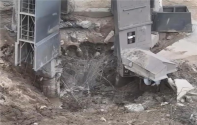I've never understand the argument of heat resistance for steel. Falcon 9's first stage is conventionally constructed and it was fine to be reused. Starship's second stage still use heat tiles that kills the argument of steel being better for heat resistance. Space shuttle is built of aluminium with heat tiles.Money was one and heat resistance was also important when you aim to reuse the thing.
You are using an out of date browser. It may not display this or other websites correctly.
You should upgrade or use an alternative browser.
You should upgrade or use an alternative browser.
NASA & World Space Exploration...News, Views, Photos & videos
- Thread starter bd popeye
- Start date
The argument for steel was back when metallic TPS was the main avenue for dissipation. Due to weight and low TRL considerations, this strategy fell through about a year after the change from carbon fiber. Then SpaceX moved on to Tufroc heat tiles.I've never understand the argument of heat resistance for steel. Falcon 9's first stage is conventionally constructed and it was fine to be reused. Starship's second stage still use heat tiles that kills the argument of steel being better for heat resistance. Space shuttle is built of aluminium with heat tiles.
They got better tiles, but how does the better tiles explain the choice of steel over aluminium when they gave up carbon fiber.The argument for steel was back when metallic TPS was the main avenue for dissipation. Due to weight and low TRL considerations, this strategy fell through about a year after the change from carbon fiber. Then SpaceX moved on to Tufroc heat tiles.
From the horses' mouth back then.They got better tiles, but how does the better tiles explain the choice of steel over aluminium when they gave up carbon fiber.
As I said,the metallic TPS avenue fell through. The interface point temperature delta vs aluminum is still relevant though.(...)
There’s a trick here, though, which I think is quite important, when you consider this as a reentry vehicle. See, here’s the other benefit of steel: It has a high melting point. Much higher than aluminum, and although carbon fiber doesn’t melt, the resin gets destroyed at a certain temperature. So typically aluminum or carbon fiber, for a steady-state operating temperature, you’re really limited to about 300 degrees Fahrenheit. It’s not that high. You can take little brief excursions above that, maybe 350. Four hundred, you’re really pushing it. It weakens. And there are some carbon fibers that can take 400 degrees Fahrenheit, but then you have strength knockdowns.
But steel, you can do 1500, 1600 degrees Fahrenheit.
(...)
For entry, you want something that can withstand high heat. So the mass of the heat shield is driven by the temperature at the interface between the heat shield tiles and the air frame. Whether it’s mechanical or if it’s bonded on—whatever the interface point is—determines the thickness of the heat shield.
On the Dragon, for example, the thickness of the heat shield tiles is actually driven by the heat soak from the heat shield getting to the bond line of the tile onto the shell. So it’s not driven by erosion of the tile. It’s actually driven by conductivity of the tile to the bond line so we don’t lose tiles as it’s descending under a chute. You don’t want to be tossing tiles off, basically.
With steel, now you’ve got something where you can comfortably be at a 1500 F interface temperature instead of, say, a 300 F, so you have five times the temperature capability at interface point. What that means is that for a steel structure, the leeward side of the back shell does not need any heat shielding.
On the windward side, what I want to do is have the first-ever regenerative heat shield. A double-walled stainless shell—like a stainless-steel sandwich, essentially, with two layers. You just need, essentially, two layers that are joined with stringers. You flow either fuel or water in between the sandwich layer, and then you have micro-perforations on the outside—very tiny perforations—and you essentially bleed water, or you could bleed fuel, through the micro-perforations on the outside. You wouldn’t see them unless you got up close. But you use transpiration cooling to cool the windward side of the rocket. So the whole thing will still look fully chrome, like this cocktail shaker in front of us. But one side will be double-walled and that serves a double purpose, which is to stiffen the structure of the vehicle so it does not suffer from the fate of the Atlas. You have a heat shield that serves double duty as structure.
Yeah.
To the best of my knowledge this has never been proposed before.
Cost against the standard Al-Li that SpaceX already uses was another consideration, although it was not stated explicitly (the cost argument was vs the outstanding carbon fiber plan for the ITS). Remember, this is designed to be a vehicle manufactured and maintained in the thousands (whether that will come true or not is something entirely different though).
Is it incompetence they didn't build a flame trench for the launch? This one is just basic maths.
Or was it they needed to rush a launch test on a wholly unsuited launch site? They'll need regulatory approvals to dredge one in a protected area.
Some baffling decisions, short of the usual ego one.

Shockingly, flame trench doesn't add much to the cost. Although the simulation analysis is only a reference to solve the complex and difficult-to-quantify problem of engine cluster reliability. But the launch pad is another issue, and its failure risk can also be estimated at low cost through simulation software. incomprehensible.

The large crater caused by the recoil engine of the Tianwen-1 lander. You know, its engine thrust is only 7500N
Last edited:
View attachment 111623
Shockingly, flame trench doesn't add much to the cost. Although the simulation analysis is only a reference to solve the complex and difficult-to-quantify problem of engine cluster reliability. But the launch pad is another issue, and its failure risk can also be estimated at low cost through simulation software. incomprehensible.
View attachment 111624
The large crater caused by the recoil engine of the Tianwen-1 lander. You know, its engine thrust is only 7500N
You can't compare Martian soil with terrestrial soil though. For all we know it is looser, and the gravity is magnitude lower there than on earth so debris get blown further away.
Some commentary on the ispace failure:
Russia's still up for participating in the ISS through 2028. The US wants 2030, iirc, and most partners have agreed. NASA will be moving onto the commercial LEO space stations sometime around then and have Gateway station.
Russia's still up for participating in the ISS through 2028. The US wants 2030, iirc, and most partners have agreed. NASA will be moving onto the commercial LEO space stations sometime around then and have Gateway station.
